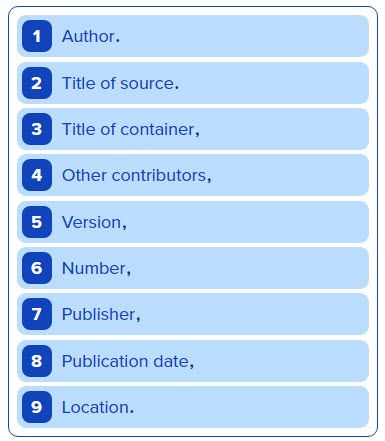MLA Works Cited page is the most important aspect of formatting that lists all sources used within the paper. In some cases, educational facilities even require the student to list only sources without corresponding in-text citations in some summaries and other types of papers, which makes it clear that the Works Cited pages are the most important thing of the formatting. However, MLA format, specifically, has unique rules for this list of works mentioned in the text. Therefore, it is important to acknowledge all existing rules on how to write an MLA Works Cited page for providing perfect academic papers when needed.
General Aspects

Above all specified MLA citation rules that are used in cases of citing different types of sources, there are general guidelines that are used in all cases. For example:
- The Works Cited page has to appear at the end of the MLA format paper (normally the last page);
- You must separate this page from the text and write it on a new page after everything;
- One should label the page with the phrase “Works Cited” (or “Work Cited” in case there is only one source used);
- The phrase “Works Cited” is not a heading. Therefore, you should not bold, not italicized, and not in quotation marks. Also, do not move it anywhere, except for the center position;
- Do not skip spaces between entries;
- Double space the whole works cited page;
- Use a hanging indent for all entries (0,5 inches).
- Arrange all entries alphabetically;
- Write full names of the authors where possible and avoid initials;
- First author’s name is inverted – the last name goes first.
- If the work does not have the author, it still must be alphabetized with all other entries.
Authors
The first element of the entry is always about the authors of the source used. Hence, if there is no author, you skip this element. Additionally, you should end this element with a period if the element exists. However, if there is at least one author, here are some aspects to consider when writing an MLA Works Cited example page:
- One author: Turner, Alex;
- Two authors: Turner, Alex, and Alex Turner;
- Three and more authors: Turner, Alex, et al.;
- Other contributors, not authors (if no authors available): Turner, Alex, translator;
- Pseudonym or Nickname: @Wr1terAlex.
- Corporate/organizational author: World Health Organization.
Title of the Source
The next step is to acknowledge the work’s title. Also, here are some additional steps on formatting the title of the source in MLA format Works Cited:
- If the source is a lengthy source that stands alone, like a book, the title has to be italicized.
- If the source is a part of a bigger work, for example, a journal’s article, magazine, chapter, series, or other minor works, it has to be put in quotation marks while the publisher (container) will be italicized.
- This part of the works cited entry also ends up with a period and has to be title cased. The conception of title case is explained on the APA citation format page.
Examples:
- Book or another stand-alone source: Book’s Title;
- Article or other minor work: “Article’s Title.”
Publishers/Containers
When you refer to a bigger work that contains your used source, you must always acknowledge it and italicize its name. For example:
- Journal of Something Cool.
However, as a new thing of formatting, it is possible that you have found a specific publisher/container on a specific database, which is also a container. Therefore, you must also acknowledge it after you mention pages used and before the URL or DOI number. For example:
- Authors. “Title of the Minor Work.” Publisher, Identification Numbers, Location.
Database , Location.
Hence, it is important to remember that in the age where all the information is presented online.
Other Contributors
When it comes to other important contributors, such as editors, translators, directors, and performers, it is important to acknowledge that they are always put after the title of the major work (for example the title of the book for book, or a journal/container’s name for a journal article). Also, it is separated by comma as it is secondary information. Hence, the performers are put after directors as they are hired by them. For example:
- Authors. Title of the Major Work. Edited by Someone, Publisher, Year of Publication.
- Authors. “Title of the Minor Work.” Publisher, translated by Someone, Identification Numbers, Location. Database, Location.
- Title of the Major Work. Directed by Someone, performance by Someone, Year of Publication, Location.
Versions
As another minor version of the data to mention in the entry, it is important to acknowledge that numbers of the version are always mentioned as a digit in MLA Works Cited page. Hence, the minor part of data ends up with a comma, like any other minor datasets. So, examples of version cited on the MLA Works Cited page are:
- Book: Authors. Title of the Major Work. Kindle ed., Publisher, Year.
- Bible: The Holy Bible. Used Version, Contributors, Year.
- Movie: Title. Directed by Someone, unrated ed., Entertainment Company, Year.
- Song: Author. “Title.” Album, explicit version, Publisher, Year, Database, URL.
Identification Numbers
When the one writes about TV shows or journals, they might have to deal with identification numbers. Also, such information is also considered secondary as not every source has them even when such rules apply to that source. Therefore, the examples of the use of such identification number will be as follows:
- For journals: Authors. “Title of the Minor Work.” Container, vol. #, no. #, Year of Publication, Pages Used.
- For TV shows: “Title of the Minor Work.” Title of the Major Work, directed by Authors, season #, episode #, Publisher, Year of Publication.
Publisher
The publisher is another aspect of the source that is considered secondary as it might not be present in the MLA sample paper. However, you should always remember to abbreviate as much information as possible as publishers’ names are usually lengthy. For example, companies, corporations, departments, periodicals, websites have to be omitted accordingly. Also, when there is more than one publisher, divide them with a slash. For example:
- XYZ Company;
- Company’s Press Center: CPC;
- NYTimes should be used for the New York Times;
- SocialMediaWebsiteVeryCool.com will go as SMWVC;
- Two publishers: Authors. Title of the Major Work. Company XYZ/Company QWE, Year of Publication.
Year of Publication
In the majority of cases, the year of publication is all that matters, but it is also important to include additional information, such as the month and the exact date, if such data is available. Hence, it is still hard to find a publication date in many sources. Therefore, this information is also secondary and is ended up with a comma if there is more information included after it (pages or URL). For example:
- “Title of the Minor Work.” Container, Year of Publication, Location.
Location
Location of the source is usually referred to its presence on the Internet. Simply, URL or doi is usually responsible for the location of the source. Additionally, this element appears the last all the time and ends with a period. Also, for print sources, the location would mean the page range that was used to gather all the information needed. Hence, that is because you will not use each and every page of the book and cite it in your MLA paper format because one would better read the original source in such case. As a result, examples for locations include:
- Authors. Title of the Major Source. Publisher, pp. #.
- Authors. “Title of the Minor Work.” Container, Identification Numbers, Year of Publication, doi:123.
- Authors. “Title of the Minor Work.” Container, Identification Numbers, Year of Publication, www.bla4bla5bla6.bla1bla2bla3.


